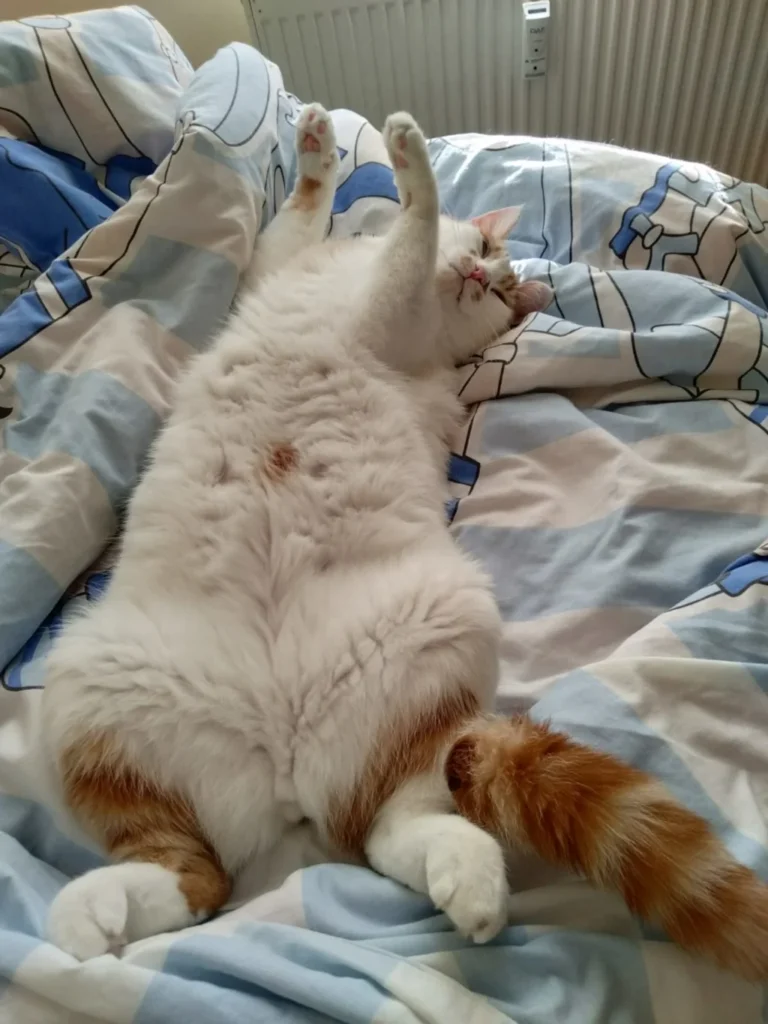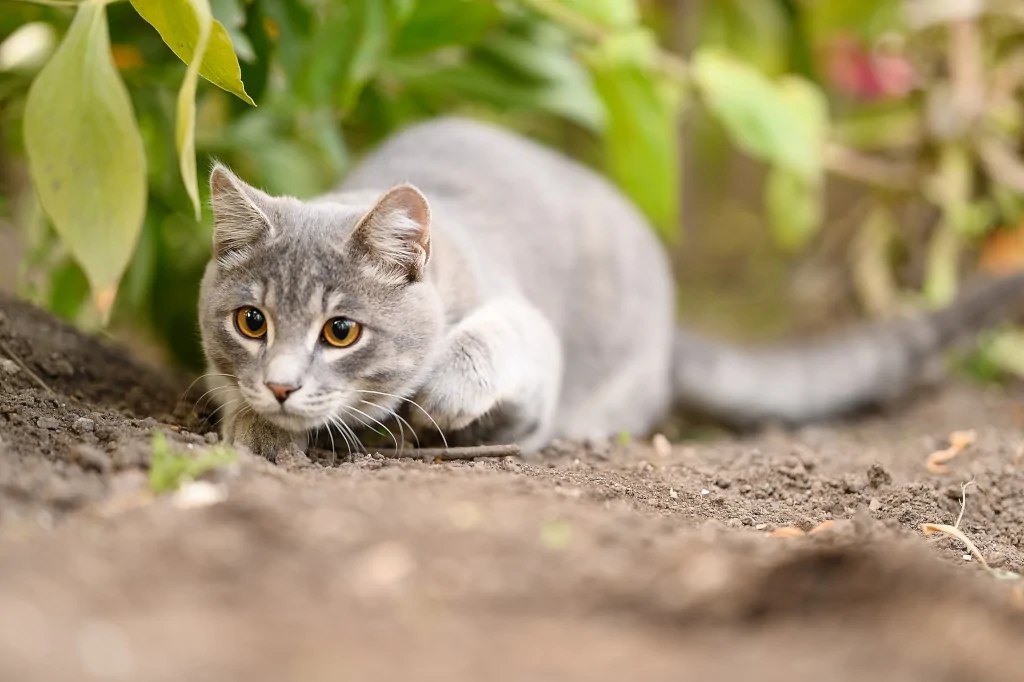Diving into the world of feline communication can feel like learning a foreign language.
Have you ever wondered what your cat is trying to tell you as they lounge in a loaf position or expose their belly? As a fellow cat lover and owner, I know how puzzling it can be to interpret these seemingly cryptic messages.
However, understanding your cat’s body posture and facial expressions can be the key to unlocking a harmonious relationship.
Let’s uncover the secrets of feline body language, so you can better understand your cat’s emotions and desires, and become a true cat whisperer.

Understanding Relaxed Body Posture
A cat’s relaxed body posture can provide valuable insight into their current emotional state.
By observing these subtle cues, you can learn when your furry friend is feeling content, safe, and comfortable. Let’s explore some common relaxed body postures and their meanings.
Loaf Position
The loaf position (also called ‘meatloaf‘) is characterized by a cat tucking their paws underneath their body while sitting upright. This posture signals that your cat is relaxed and content but still alert.

My male cat, Smokey, often assumes the loaf position when he’s quietly observing his surroundings, ready to spring into action if something catches his interest.
Belly-up
A cat lying belly-up, with their legs spread out and their belly exposed, is the epitome of trust and comfort. This vulnerable position demonstrates that your cat feels safe and secure in their environment.
When your cat lounges belly-up on the couch next to you, it means that they’re completely at ease and they cherish the time together.

In these relaxed positions, you can better appreciate the unique bond you share with your feline companion, knowing they trust you and feel comfortable in your presence.
Defensive and Fearful Body Language
Imagine your cat transforming into a puffed-up, arched-back creature straight out of a spooky movie scene. It’s not Halloween, but your feline friend is telling you something important through their defensive and fearful body language.
Let’s look into some typical defensive and fearful body language signs that may indicate your cat is feeling threatened or uncomfortable.
Crouching
While not always the case, a crouching cat is often a scared cat.
When a cat lowers their body close to the ground, tucks their tail around their body, and hunches their shoulders, they’re likely feeling fearful or defensive. The shoulders are a giveaway of fear.
Once, during a thunderstorm, I found Smokey crouched in a corner, his body low and tense, which signaled to me that he was anxious about the loud noises outside. It happens, so watch your cat carefully.
Arched Back
An arched back, accompanied by puffed-up fur and an erect tail, is a classic sign of a frightened or defensive cat.
This posture makes the cat appear larger, an instinctive reaction to ward off potential threats. The tail doesn’t always need to be upright, but it depends on the situation.

I vividly recall an encounter between Smokey and a stray cat outside our window, during which Smokey’s back arched and his fur bristled as he tried to assert his dominance.
Flattened Body
A cat with a flattened body is usually trying to make themselves as small and inconspicuous as possible to avoid perceived danger, or to hide during a hunt (for outdoor cats).
For those avoid danger, they may press their body against the ground, with their ears flattened and their tail tucked under, signaling that they feel extremely threatened. On the other hand, while hunting, their ears will be high up, but their body will still be flattened to avoid detection.

Sometimes, though, cats would do this when they’re excited, or during playtime mimicking they’re ready to jump at the pray, or a “pray-like” toy.

By being aware of these defensive and fearful body language cues, you can support your cat in times of stress, offering reassurance and a safe haven to help them regain their composure and confidence.
Facial Expressions: A Window Into Your Cat’s Emotions
Peering into your cat’s eyes and observing their facial expressions can be like opening a gateway to their innermost thoughts and feelings.
As cat owners, we must learn to read the subtle cues in our feline friends’ faces to better understand and cater to their emotional needs. Let’s explore some key facial expressions that can help you decipher your cat’s emotional state.
Relaxed Whiskers and Mouth
When your cat is content and relaxed, their whiskers will be in their natural position, extending sideways from their face, and their mouth will be closed or slightly open.

A purring cat with relaxed whiskers is often a sign of a happy and satisfied feline.
For example, if your cat is curled up on your lap, with their whiskers gently twitching, you can be sure that your cat knows they are enjoying your bonding time together.
Tensed Whiskers and Bared Teeth
On the other hand, tensed whiskers and bared teeth indicate that your cat is either frightened, angry, or in pain. If your cat’s whiskers are pulled back and their teeth are exposed, it’s essential to give them some space and try to identify the source of their distress.
I remember when Smokey injured his paw once. His whiskers were tensed, and he bared his teeth every time I tried to examine the wound, showing me that he was in discomfort.
If you learn your cat’s body signals and facial expressions, you’ll gain insight into your cat’s emotions, which fosters a deeper understanding and connection with your furry companion.
Pay close attention to those whiskers and expressive eyes, and you’ll be well on your way to deciphering the mysteries of your cat’s inner world.
Since I love this guy so much, and think his advice is rock solid, here’s some more insight from my man Jackson Galaxy:
FAQs
Why does my cat arch its back when it’s scared?
A cat arches its back when scared to appear larger and more intimidating to potential threats, as a defensive mechanism.
What does it mean when a cat shows its belly?
When a cat shows its belly, it can be a sign of trust and vulnerability, or an invitation for play. However, it could also be a defensive posture, so it’s important to observe your cat’s body language and facial expressions.
How can I tell if my cat is anxious or stressed?
To tell if your cat is anxious or stressed, look for signs such as excessive grooming, hiding, vocalizing, loss of appetite, or changes in body posture and facial expressions.
What does a slow blink from my cat mean?
A slow blink from your cat is often considered a sign of affection and trust, as it communicates that they feel safe and relaxed in your presence.
Alex, a passionate animal lover, has experience in training and understanding animal behavior. As a proud pet parent to two dogs and three cats, he founded AnimalReport.net to share insights from animal experts and expand his knowledge of the animal kingdom.




